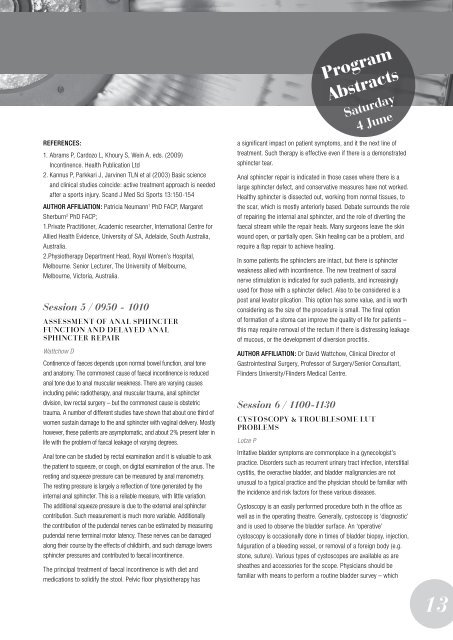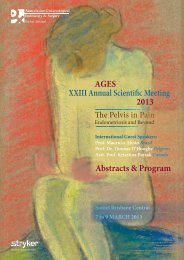to Obstetric Trauma Pelvic Floor Repair Surgical Essentials - AGES
to Obstetric Trauma Pelvic Floor Repair Surgical Essentials - AGES
to Obstetric Trauma Pelvic Floor Repair Surgical Essentials - AGES
You also want an ePaper? Increase the reach of your titles
YUMPU automatically turns print PDFs into web optimized ePapers that Google loves.
REFERENCES:<br />
1. Abrams P, Cardozo L, Khoury S, Wein A, eds. (2009)<br />
Incontinence. Health Publication Ltd<br />
2. Kannus P, Parkkari J, Jarvinen TLN et al (2003) Basic science<br />
and clinical studies coincide: active treatment approach is needed<br />
after a sports injury. Scand J Med Sci Sports 13:150-154<br />
AUTHOR AFFILIATION: Patricia Neumann 1 PhD FACP, Margaret<br />
Sherburn 2 PhD FACP;<br />
1.Private Practitioner, Academic researcher, International Centre for<br />
Allied Health Evidence, University of SA, Adelaide, South Australia,<br />
Australia.<br />
2.Physiotherapy Department Head, Royal Women’s Hospital,<br />
Melbourne. Senior Lecturer, The University of Melbourne,<br />
Melbourne, Vic<strong>to</strong>ria, Australia.<br />
Session 5 / 0950 - 1010<br />
Assessment of anal sphincter<br />
function and delayed anal<br />
sphincter repair<br />
Wattchow D<br />
Continence of faeces depends upon normal bowel function, anal <strong>to</strong>ne<br />
and ana<strong>to</strong>my. The commonest cause of faecal incontinence is reduced<br />
anal <strong>to</strong>ne due <strong>to</strong> anal muscular weakness. There are varying causes<br />
including pelvic radiotherapy, anal muscular trauma, anal sphincter<br />
division, low rectal surgery – but the commonest cause is obstetric<br />
trauma. A number of different studies have shown that about one third of<br />
women sustain damage <strong>to</strong> the anal sphincter with vaginal delivery. Mostly<br />
however, these patients are asymp<strong>to</strong>matic, and about 2% present later in<br />
life with the problem of faecal leakage of varying degrees.<br />
Anal <strong>to</strong>ne can be studied by rectal examination and it is valuable <strong>to</strong> ask<br />
the patient <strong>to</strong> squeeze, or cough, on digital examination of the anus. The<br />
resting and squeeze pressure can be measured by anal manometry.<br />
The resting pressure is largely a reflection of <strong>to</strong>ne generated by the<br />
internal anal sphincter. This is a reliable measure, with little variation.<br />
The additional squeeze pressure is due <strong>to</strong> the external anal sphincter<br />
contribution. Such measurement is much more variable. Additionally<br />
the contribution of the pudendal nerves can be estimated by measuring<br />
pudendal nerve terminal mo<strong>to</strong>r latency. These nerves can be damaged<br />
along their course by the effects of childbirth, and such damage lowers<br />
sphincter pressures and contributed <strong>to</strong> faecal incontinence.<br />
The principal treatment of faecal incontinence is with diet and<br />
medications <strong>to</strong> solidify the s<strong>to</strong>ol. <strong>Pelvic</strong> floor physiotherapy has<br />
Program<br />
Abstracts<br />
Saturday<br />
4 June<br />
a significant impact on patient symp<strong>to</strong>ms, and it the next line of<br />
treatment. Such therapy is effective even if there is a demonstrated<br />
sphincter tear.<br />
Anal sphincter repair is indicated in those cases where there is a<br />
large sphincter defect, and conservative measures have not worked.<br />
Healthy sphincter is dissected out, working from normal tissues, <strong>to</strong><br />
the scar, which is mostly anteriorly based. Debate surrounds the role<br />
of repairing the internal anal sphincter, and the role of diverting the<br />
faecal stream while the repair heals. Many surgeons leave the skin<br />
wound open, or partially open. Skin healing can be a problem, and<br />
require a flap repair <strong>to</strong> achieve healing.<br />
In some patients the sphincters are intact, but there is sphincter<br />
weakness allied with incontinence. The new treatment of sacral<br />
nerve stimulation is indicated for such patients, and increasingly<br />
used for those with a sphincter defect. Also <strong>to</strong> be considered is a<br />
post anal leva<strong>to</strong>r plication. This option has some value, and is worth<br />
considering as the size of the procedure is small. The final option<br />
of formation of a s<strong>to</strong>ma can improve the quality of life for patients –<br />
this may require removal of the rectum if there is distressing leakage<br />
of mucous, or the development of diversion proctitis.<br />
AUTHOR AFFILIATION: Dr David Wattchow, Clinical Direc<strong>to</strong>r of<br />
Gastrointestinal Surgery, Professor of Surgery/Senior Consultant,<br />
Flinders University/Flinders Medical Centre.<br />
Session 6 / 1100-1130<br />
Cys<strong>to</strong>scopy & troublesome LUT<br />
problems<br />
Lotze P<br />
Irritative bladder symp<strong>to</strong>ms are commonplace in a gynecologist’s<br />
practice. Disorders such as recurrent urinary tract infection, interstitial<br />
cystitis, the overactive bladder, and bladder malignancies are not<br />
unusual <strong>to</strong> a typical practice and the physician should be familiar with<br />
the incidence and risk fac<strong>to</strong>rs for these various diseases.<br />
Cys<strong>to</strong>scopy is an easily performed procedure both in the office as<br />
well as in the operating theatre. Generally, cys<strong>to</strong>scopy is ‘diagnostic’<br />
and is used <strong>to</strong> observe the bladder surface. An ‘operative’<br />
cys<strong>to</strong>scopy is occasionally done in times of bladder biopsy, injection,<br />
fulguration of a bleeding vessel, or removal of a foreign body (e.g.<br />
s<strong>to</strong>ne, suture). Various types of cys<strong>to</strong>scopes are available as are<br />
sheathes and accessories for the scope. Physicians should be<br />
familiar with means <strong>to</strong> perform a routine bladder survey – which<br />
13

















